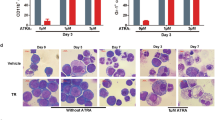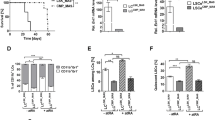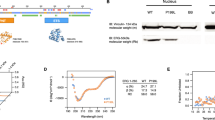Abstract
Retinoic acid receptor (RA) heterodimer (RAR/RXR) activities have been shown to be repressed by transcriptional co-repressor, SMRT/N-CoR, in the absence of the ligand while upon all-trans retionic acid (ATRA) treatment, SMRT/N-CoR is dissociated from RARα leading to gene expression by the recruitment of transcriptional co-activators to the transcriptional complex. The difference in response to ATRA therapy between acute promyelocytic leukemia (APL) patients with PML-RARα fusion and PLZF-RARα fusion has recently been found to be partially due to the strong association of the transcriptional co-repressor, SMRT/N-CoR, with PLZF domain. We demonstrate that SMRT association, as with PML-RARα, can be released from NPM-RARα at pharmacological concentration of ATRA (10−6 M). Moreover, we show for the first time that the interaction between the transcriptional co-activator, RIP-140, and PML-, PLZF- or NPM-RARα fusion proteins can be positively stimulated by ATRA although they are less sensitive as compared with the wild-type RARα. Our results suggest that the dissociation of transcriptional co-repressors, SMRT/N-CoR, and recruitment of co-activators, eg RIP-140, to APL-associated fusion proteins constitute a common molecular mechanism in APL and underlie the responsiveness of the disease to RA therapy.
This is a preview of subscription content, access via your institution
Access options
Subscribe to this journal
Receive 12 print issues and online access
$259.00 per year
only $21.58 per issue
Buy this article
- Purchase on Springer Link
- Instant access to full article PDF
Prices may be subject to local taxes which are calculated during checkout




Similar content being viewed by others
References
de Thé H, Lavau C, Marchio A, Chomienne C, Degos L, Dejean A . The PML-RARα fusion mRNA generated by the t(15;17) translocation in acute promyelocytic leukemia encodes a functionally altered RAR Cell 1991 66: 675–684
Goddard AD, Borrow J, Freemont P, Solomon E . Characterization of a zinc finger gene disrupted by the t(15;17) in acute promyelocytic leukemia Science 1991 254: 1371–1374
Kakizuka A, Miller WH Jr, Umesono K, Warrell RP Jr, Frankel SR, Murty VVVS, Dmitrovsky E, Evans RM . Chromosome translocation t(15;17) in human acute promyelocytic leukemia fuses RARα with a novel putative transcription factor, PML Cell 1991 66: 663–674
Chen Z, Brand NJ, Chen A, Chen SJ, Tong JH, Wang ZY, Waxman S, Zelent A . Fusion between a novel Krüppel-like zinc finger gene and the retinoic acid receptor-α locus due to a variant t(11;17) translocation associated with acute promyelocytic leukaemia EMBO J 1993 12: 1161–1167
Redner RL, Rush EA, Faas S, Rudert WA, Corey SJ . The t(5;17) variant of acute promyelocytic leukemia expresses a nucleophosmin-retinoic acid receptor fusion Blood 1996 87: 882–886
Wells RA, Catzavelos C, Kamel-Reid S . Fusion of retinoic acid receptor alpha to NuMA, the nuclear mitotic apparatus protein, by a variant translocation in acute promyelocytic leukaemia Nat Genet 1997 17: 109–113
Mangelsdorf DJ, Thummel C, Beato M, Herrlich P, Schutz G, Umesono K, Blumberg B, Kastner P, Mark M, Chambon P, Evans RM . The nuclear receptor superfamily–the 2nd decade Cell 1995 83: 835–839
Leid M, Kastner P, Chambon P . Multiplicity generates diversity in the retinoic acid signalling pathways Trends Biochem Sci 1992 17: 427–433
Chambon P . A decade of molecular biology of retinoic acid receptors FASEB J 1996 10: 940–954
Collins SJ, Tsai S . Retinoic acid receptors in hematopoiesis Curr Top Microbiol Immunol 1996 211: 7–15
Hörlein AJ, Näär AM, Heinzel T, Torchia J, Gloss B, Kurokawa R, Ryan A, Kamei Y, Söderström M, Glass CK . Rosenfeld MG. Ligand-independent repression by the thyroid hormone receptor mediated by a nuclear receptor co-repressor Nature 1995 377: 397–404
Chen JD, Evans RM . A transcriptional co-repressor that interacts with nuclear hormone receptors Nature 1995 377: 454–457
Kurokawa R, Söderström M, Hörlein A, Halachmi S, Brown M, Rosenfeld MG, Glass CK . Polarity-specific activities of retinoic acid receptors determined by a co-repressor Nature 1995 377: 451–454
Wang H, Stillman DJ . In vitro regulation of a SIN3-dependent DNA-binding activity by stimulatory and inhibitory factors Proc Natl Acad Sci USA 1990 87: 9761–9765
Wang H, Clark I, Nicholson PR, Herskowitz I, Stillman DJ . The Saccharomyces cerevisiae SIN3 gene, a negative regulator of HO, contains four paired amphipathic helix motifs Mol Cell Biol 1990 10: 5927–5936
Wang H, Stillman DJ . Transcriptional repression in Saccharomyces cerevisiae by a SIN3-LexA fusion protein Mol Cell Biol 1993 13: 1805–1814
Taunton J, Hassig CA, Schreiber SL . A mammalian histone deacetylase related to the yeast transcriptional regulator Rpd3p Science 1996 272: 408–411
Perez A, Kastner P, Sethi S, Lutz Y, Reibel C, Chambon P . PMLRAR homodimers: distinct DNA binding properties and heteromeric interactions with RXR EMBO J 1993 12: 3171–3182
Licht JD, Shaknovich R, English MA, Melnick A, Li J-Y, Reddy JC, Dong S, Chen S-J, Zelent A, Waxman S . Reduced and altered DNA-binding and transcriptional properties of the PLZF-retinoic acid receptor-α chimer generated in t(11;17)-associated acute promyelocytic leukemia Oncogene 1996 12: 323–336
Dong S, Zhu J, Reid A, Strutt P, Guidez F, Zhong H-J, Wang Z-Y, Licht J, Waxman S, Chomienne C, Zelent A, Chen S-J . Amino-terminal protein–protein interaction motif (POZ-domain) is responsible for activities of the promyelocytic leukaemia zinc finger-retinoic acid receptor-α fusion protein Proc Natl Acad Sci USA 1996 93: 3624–3629
Huang ME, Ye YC, Chen SR, Cai JR, Lu JX, Zhao L, Gu RJ, Wang ZY . Use of all-trans retinoic acid in the treatment of acute promyelocytic leukaemia Blood 1988 72: 567–572
Redner RL, Corey SJ, Rush EA . Differentiation of t(5;17) variant acute promyelocytic leukemic blasts by all-trans retinoic acid Leukemia 1997 11: 1014–1016
Licht JD, Chen A, Goy A, Wu Y, Scott AA, DeBlasio A, Miller WH, Zelenetz AD, William CL, Head DR, Chomienne C, Chen Z, Chen SJ, Zelent A, MacIntyre E, Veil A, Cortes J, Kantarjian H, Waxman S . Clinical and molecular characterization of acute promyelocytic leukemia associated with translocation (11;17) Blood 1995 85: 1083–1094
Hong S-H, David G, Wong C-W, Dejean A, Privalsky ML . SMRT corepressor interacts with PLZF and with the PML-retinoic acid receptor α (RARα) and PLZF-RARα oncoproteins associated with acute promyelocytic leukemia Proc Natl Acad Sci USA 1997 94: 9028–9033
Lin RJ, Nagy L, Inoue S, Shao W, Miller WH Jr, Evans RM . Role of the histone deacetylase complex in acute promyelocytic leukaemia Nature 1998 391: 811–814
He L-Z, Guidez F, Tribioli C, Peruzzi D, Ruthardt M, Zelent A, Pandolfi PP . Distinct interactions of PML-RARα and PLZF-RARα with co-repressors determine differential responses to RA in APL Nat Genet 1998 18: 126–135
Grignani F, De Matteis S, Nervi C, Tomassoni L, Gelmetti V, Cioce M, Fanelli M, Ruthardt M, Ferrara FF, Zamir I, Seiser C, Grignani F, Lazar MA, Minucci S, Pelicci PG . Fusion proteins of the retinoic acid receptor-α recruit histone deacetylase in promyelocytic leukaemia Nature 1998 391: 815–818
Guidez F, Ivins S, Zhu J, Söderström M, Waxman S, Zelent A . Reduced retinoic acid-sensitivities of nuclear receptor corepressor binding to PML- and PLZF-RARα underlie molecular pathogenesis and treatment of acute promyelocytic leukemia Blood 1998 91: 2634–2642
David G, Alland L, Hong S-H, Wong C-W, DePinho RA, Dejean A . Histone deacetylase associated with mSin3A mediates repression by the acute promyelocytic leukemia-associated PLZF protein Oncogene 1998 16: 2549–2556
Cavailles V, Dauvois S, Danielian PS, Parker MG . Interaction of proteins with transcriptionally active estrogen receptors Proc Natl Acad Sci USA 1994 91: 10009–10013
Cavailles V, Dauvois S, L'Horset F, Lopez G, Hoare S, Kushner PJ, Parker MG . Nuclear factor RIP140 modulates transcriptional activation by the estrogen receptor EMBO J 1995 14: 3741–3751
L'Horset F, Dauvois S, Heery DM, Cavailles V, Parker MG . RIP-140 interacts with multiple nuclear receptors by means of two distinct sites Mol Cell Biol 1996 16: 6029–6036
Henttu PMA, Kalkhoven E, Parker MG . AF-2 activity and recruitment of steroid receptor coactivator 1 to the estrogen receptor depend on a lysine residue conserved in nuclear receptors Mol Cell Biol 1997 17: 1832–1839
Horwitz KB, Jackson TA, Bain DL, Richer JK, Takimoto GS, Tung L . Nuclear receptor coactivators and corepressors Mol Endocrinol 1996 10: 1167–1177
Jansen JH, Mahfoudi A, Rambaud S, Lavau C, Wahli W, Dejean A . Multimeric complexes of the PML-retinoic acid receptor alpha fusion protein in acute promyelocytic leukemia cells and interference with retinoid and peroxisome-proliferator signaling pathways Proc Natl Acad Sci USA 1995 92: 7401–7405
Liu Q-R, Chan PK . Formation of nucleophosmin/B23 oligomers requires both the amino- and the carboxyl-terminal domains of the protein Eur J Biochem 1991 200: 715–721
Bischof D, Pulford K, Mason DY, Morris SW . Role of the nucleophosmin (NPM) portion of the non-Hodgkin's lymphoma-associated NPM-anaplastic lymphoma kinase fusion protein in oncogenesis Mol Cell Biol 1997 17: 2312–2325
Nagpal S, Saunders M, Kastner P, Durand B, Nakshatri J, Chambon P . Promotor context- and response element-dependent specificity of the transcriptional activation and modulating functions of retinoic acid receptors Cell 1992 70: 1007–1019
Nagpal S, Friant S, Nakshatri H, Chambon P . RARα and RXRα: evidence for two autonomous transactivation functions (AF-1 and AF-2) and heterodimerization in vivo EMBO J 1993 12: 2349–2360
Leid M, Kastner P, Lyons R, Nakshatri H, Saunders M, Zacharewski T, Chen JY, Staub A, Garnier JM, Mader S, Chambon P . Purification, cloning and RXR identity of the HeLa cell factor with which RAR or TR heterodimerizes to bind target sequences efficiently Cell 1992 68: 377–395
Green S . Nuclear hormone receptors. Promiscuous liaisons Nature 1993 361: 590–591
Heery DM, Kalkhoven E, Hoare S, Parker MG . A signature motif in transcriptional co-activators mediates binding to nuclear receptors Nature 1997 387: 733–736
Kastner P, Perez A, Lutz Y, Rochette-Egly C, Gaub MP, Durand B, Lanotte M, Berger R, Chambon P . Structure, localization and transcriptional properties of two classes of retinoic acid receptor alpha fusion proteins in acute promyelocytic leukemia (APL): structural similarities with a new family of oncoproteins EMBO J 1992 11: 629–642
Wang Z-G, Ruggero D, Ronchetti S, Zhong S, Gaboli M, Rivi R, Pandolfi PP . Pml is essential for multiple apoptotic pathways Nat Genet 1998 20: 266–272
Quignon F, De Bels F, Koken M, Feunteun J, Ameisen JC, de Thé H . PML induces a novel caspase-independent death process Nat Genet 1998 20: 259–265
Acknowledgements
We are indebted to Dr SW Morris, St Jude Children's Hospital, Memphis, TN, for kindly sending us the NPM-ALK plasmid, which was helpful in the construction of NPM-RARα expression plasmid. We thank Professor Zhu Chen, Shanghai Second Medical University and Dr A Zelent, LRF, London for helpful discussion. This work was supported by a RGC fundable-HKU block grant, 344-046-0001.
Author information
Authors and Affiliations
Rights and permissions
About this article
Cite this article
So, C., Dong, S., So, C. et al. The impact of differential binding of wild-type RARα, PML-, PLZF- and NPM-RARα fusion proteins towards transcriptional co-activator, RIP-140, on retinoic acid responses in acute promyelocytic leukemia. Leukemia 14, 77–83 (2000). https://doi.org/10.1038/sj.leu.2401643
Received:
Accepted:
Published:
Issue Date:
DOI: https://doi.org/10.1038/sj.leu.2401643
Keywords
This article is cited by
-
Evidence of functional interaction between NuMA-RARα and RXRα in an in vivo model of acute promyelocytic leukemia
Oncogene (2008)
-
Variations on a theme: the alternate translocations in APL
Leukemia (2002)
-
Orchestration of multiple arrays of signal cross-talk and combinatorial interactions for maturation and cell death: another vision of t(15;17) preleukemic blast and APL-cell maturation
Oncogene (2001)
-
Translocations of the RARα gene in acute promyelocytic leukemia
Oncogene (2001)
-
Pathobiology of NPM-ALK and variant fusion genes in anaplastic large cell lymphoma and other lymphomas
Leukemia (2000)



